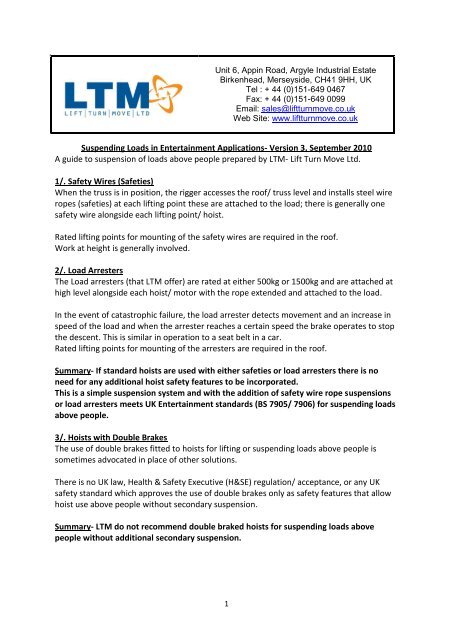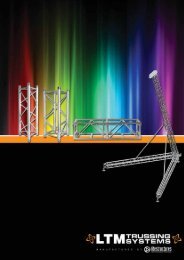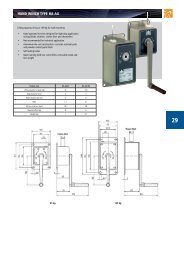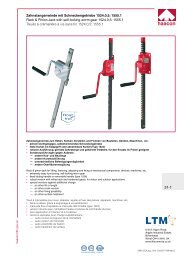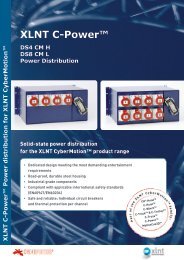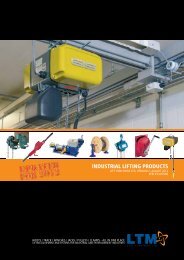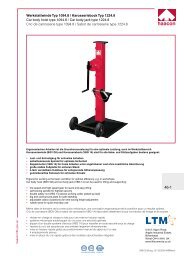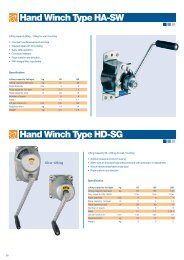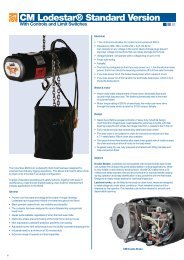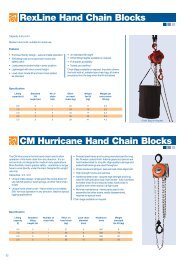Factor of Safety - Lift Turn Move
Factor of Safety - Lift Turn Move
Factor of Safety - Lift Turn Move
Create successful ePaper yourself
Turn your PDF publications into a flip-book with our unique Google optimized e-Paper software.
Unit 6, Appin Road, Argyle Industrial Estate<br />
Birkenhead, Merseyside, CH41 9HH, UK<br />
Tel : + 44 (0)151-649 0467<br />
Fax: + 44 (0)151-649 0099<br />
Email: sales@liftturnmove.co.uk<br />
Web Site: www.liftturnmove.co.uk<br />
Suspending Loads in Entertainment Applications- Version 3, September 2010<br />
A guide to suspension <strong>of</strong> loads above people prepared by LTM- <strong>Lift</strong> <strong>Turn</strong> <strong>Move</strong> Ltd.<br />
1/. <strong>Safety</strong> Wires (Safeties)<br />
When the truss is in position, the rigger accesses the ro<strong>of</strong>/ truss level and installs steel wire<br />
ropes (safeties) at each lifting point these are attached to the load; there is generally one<br />
safety wire alongside each lifting point/ hoist.<br />
Rated lifting points for mounting <strong>of</strong> the safety wires are required in the ro<strong>of</strong>.<br />
Work at height is generally involved.<br />
2/. Load Arresters<br />
The Load arresters (that LTM <strong>of</strong>fer) are rated at either 500kg or 1500kg and are attached at<br />
high level alongside each hoist/ motor with the rope extended and attached to the load.<br />
In the event <strong>of</strong> catastrophic failure, the load arrester detects movement and an increase in<br />
speed <strong>of</strong> the load and when the arrester reaches a certain speed the brake operates to stop<br />
the descent. This is similar in operation to a seat belt in a car.<br />
Rated lifting points for mounting <strong>of</strong> the arresters are required in the ro<strong>of</strong>.<br />
Summary- If standard hoists are used with either safeties or load arresters there is no<br />
need for any additional hoist safety features to be incorporated.<br />
This is a simple suspension system and with the addition <strong>of</strong> safety wire rope suspensions<br />
or load arresters meets UK Entertainment standards (BS 7905/ 7906) for suspending loads<br />
above people.<br />
3/. Hoists with Double Brakes<br />
The use <strong>of</strong> double brakes fitted to hoists for lifting or suspending loads above people is<br />
sometimes advocated in place <strong>of</strong> other solutions.<br />
There is no UK law, Health & <strong>Safety</strong> Executive (H&SE) regulation/ acceptance, or any UK<br />
safety standard which approves the use <strong>of</strong> double brakes only as safety features that allow<br />
hoist use above people without secondary suspension.<br />
Summary- LTM do not recommend double braked hoists for suspending loads above<br />
people without additional secondary suspension.<br />
1
Hoists with Special <strong>Safety</strong> Features- The Options for suspending or moving loads above<br />
people<br />
The following has been prepared using the British Standard and the BGV specifications from<br />
VPLT in Germany (VPLT is an association similar to PLASA and ABTT).<br />
Use<br />
Use<br />
Origin <strong>of</strong> Regulation<br />
BGV D8/<br />
Normal<br />
Hoist<br />
Hoists to<br />
BS 7906:<br />
Part 1<br />
Category A<br />
BGV D8/<br />
Normal hoist<br />
with<br />
Secondary<br />
<strong>Safety</strong><br />
Component<br />
BGV D8<br />
Plus<br />
BGV C1<br />
Use According to BGV Regulations<br />
When people are present below the load<br />
UK/Europe<br />
/ Germany UK Germany Germany Germany<br />
Assembly/disassembly,<br />
set up<br />
Not<br />
Permitted<br />
Permitted<br />
Not<br />
Permitted<br />
Not<br />
Permitted<br />
Permitted<br />
Load–holding<br />
Not<br />
Permitted Permitted Permitted Permitted Permitted<br />
Staging processes<br />
involving movement<br />
Not<br />
Permitted<br />
Permitted<br />
Not<br />
Permitted<br />
Not<br />
Permitted<br />
Permitted<br />
4/. Chain Hoists to BS 7906 Part 1: 2005- Category A, Use <strong>of</strong> <strong>Lift</strong>ing Equipment for<br />
Performance, Broadcast and Similar Applications<br />
This is a British Standard which details Electric Chain Hoists suitable for lifting or suspending<br />
loads above people without additional safety measures.<br />
The standard divides hoists into Category A and Category B hoists.<br />
Category A Hoists are declared by the manufacturer as intended for use by the<br />
entertainment industry for lifting and suspending loads over people and meeting the<br />
requirements <strong>of</strong> BS 7905-1 or DIN 56925. Category A hoists are suitable for lifting or<br />
suspending loads above people without additional safety measures.<br />
The following features are required.<br />
Double Brakes - Essential<br />
Brake Position - Brake acts directly to stop the load (the overload clutch is not in the drive<br />
train)<br />
Limit Switches – Normal top and bottom and emergency limits are essential<br />
Mechanical Stops - End <strong>of</strong> travel (mechanical) stops essential<br />
Emergency Stop - Essential<br />
Secondary Suspension - Not necessary<br />
Controller – Desirable<br />
Chain Container - 50% fullness maximum<br />
Note- We <strong>of</strong>ten receive enquiries for hoists to this standard but with increased factors <strong>of</strong><br />
safety, for ease we detail 3 safety factors with permissible loadings in our catalogue, we are<br />
asked for these different factors on a regular basis.<br />
2
Category B Hoists are normal hoists which do not meet Category A requirements, these<br />
require a secondary suspension system for suspending loads above people. (These could be<br />
designated as hoists to German BGV D8 or normal hoists.)<br />
5/. Hoists to BGV D8 plus: VPLT SR 2.0, Code <strong>of</strong> Practice for Event Technology<br />
This is a German safety regulation published by VPLT, for hoists used for lifting loads during<br />
setup and with the special characteristics <strong>of</strong> being able to hold loads at rest above people<br />
without using a secondary safety component.<br />
These hoists allow the following (when people are present below the load):<br />
Load holding when loads are static<br />
The hoists do not allow (when people are present below the load):<br />
Assembly/ disassembly during set up<br />
Staging processes involving movement.<br />
The hoists have the following features:<br />
2 separate brakes<br />
Limit switches not required (but available on some hoists)<br />
Overload monitoring – shutdown. A friction clutch is permitted if it is not within the<br />
load path when the Electric Chain Hoist is disconnected from the power supply.<br />
Underload monitoring- not required<br />
<strong>Factor</strong> <strong>of</strong> <strong>Safety</strong> – 10:1, the lifting capacity is de-rated*.<br />
Note* According to instructions from the German employer's Liability Insurance Association<br />
the ratings <strong>of</strong> BGV D8 Plus and BGV C1 Hoists have to change. The <strong>Lift</strong>ing Capacity now<br />
becomes Rated <strong>Lift</strong>ing Capacity, this is calculated by dividing the maximum lifting capacity<br />
(with 10:1 safety factor) by the dynamic factor; this has the effect <strong>of</strong> reducing all the<br />
previously stated <strong>Lift</strong>ing Capacities.<br />
Note- the standard calls for Direct Control Hoists (without controls and limit switches),<br />
outside <strong>of</strong> Germany we generally <strong>of</strong>fer Low Voltage Hoists with limit switches as we<br />
consider this a safer unit which still meets the standard.<br />
Summary- When hoists to BGV D8 Plus are used for load holding, a secondary suspension<br />
system is not required and people are allowed to work below a raised load when in a set<br />
position. Hoists to BGV D8 Plus are not rated for moving loads above people.<br />
Although this is a German regulation, there should be no doubting its safety. BGV D8 Plus<br />
hoists are not <strong>of</strong>ficially approved for use in the UK and selection is subject to a risk<br />
assessment being carried out.<br />
6/. Hoists to BGV C1: VPLT SR 2.0, Code <strong>of</strong> Practice for Event Technology<br />
These hoists allow the following - when people are present below the load:<br />
Assembly/disassembly during set up<br />
Load holding when loads are static<br />
Staging processes involving movement<br />
These hoists are adapted to have the following features:<br />
3
2 separate brakes<br />
4 position limit switches – limit switches & emergency limit switches<br />
Shutdown at 120% <strong>of</strong> rated load (using a loadcell)<br />
Underload monitoring – (using a loadcell)<br />
<strong>Factor</strong> <strong>of</strong> <strong>Safety</strong> – 10:1, the lifting capacity is de-rated*<br />
Note* According to instructions from the German employer's Liability Insurance Association<br />
the ratings <strong>of</strong> BGV D8 Plus and BGV C1 Hoists have to change. The <strong>Lift</strong>ing Capacity now<br />
becomes Rated <strong>Lift</strong>ing Capacity, this is calculated by dividing the maximum lifting capacity<br />
(with 10:1 safety factor) by the dynamic factor; this has the effect <strong>of</strong> reducing all the<br />
previously stated <strong>Lift</strong>ing Capacities.<br />
Hoists to this regulation are tested and approved by TUV <strong>of</strong>fices throughout Germany and<br />
relevant certification issued. Control systems do not require an <strong>of</strong>ficial BGV C1 approval<br />
certificate. Each BGV C1 system has to be approved on site by a special theatrical engineer<br />
when integration tests are carried out.<br />
The only exception is SIL 3 control systems; these have to have a separate <strong>of</strong>ficial approval.<br />
Control systems monitor the special features and in the event <strong>of</strong> any <strong>of</strong> the safety features<br />
being breached- overload, slack chain or emergency limit being contacted, the entire system<br />
shuts down. A bypass for the emergency limit is required so that an inspection engineer is<br />
able to test limit switches and brakes <strong>of</strong> the hoists individually<br />
Control systems operate manually or can operate via computerisation using encoders which<br />
can monitor the position <strong>of</strong> the hoists/ load. Often encoders are required to control hoist<br />
positions etc.<br />
Summary- When hoists to BGV C1 are used, a secondary suspension system is not<br />
required and people are allowed to work below a raised or moving load.<br />
Although this is a German regulation, there should be no doubting its safety. BGV C1<br />
hoists are not <strong>of</strong>ficially approved for use in the UK and selection is subject to a risk<br />
assessment being carried out.<br />
7/. CWA 15902- 1, <strong>Lift</strong>ing & Load- Bearing Equipment for Stages and other Production<br />
Areas within the Entertainment Industry- Part 1.<br />
This is a relatively new CEN agreement dated December 2008 to try and standardise on<br />
procedures for entertainment lifting equipment. The document states- The CEN Workshop<br />
Agreement can in no way be held as being an <strong>of</strong>ficial standard.<br />
(LTM thoughts- This seems to call for single brakes and the lifting capacity needs to be<br />
derated to 50% <strong>of</strong> the normal working load limit. No other safety features or other<br />
regulations are required. This is for suspension only, not for moving loads above people.<br />
I refer below to specific details in the document to help users assess the agreement.<br />
Page 31 – 7 Overhead suspension <strong>of</strong> loads- states that where standard lifting machinery<br />
and accessories compliant to Machinery Directive 2006/42EC are used to provide overhead<br />
suspension <strong>of</strong> loads and where it is not required to move these loads above people, the<br />
following applies after a satisfactory risk assessment has been carried out.<br />
4
7.2 <strong>Lift</strong>ing Equipment- Standard lifting equipment should be loaded to no more than 0.5<br />
times the safe working load as given by the manufacturer.<br />
(LTM thoughts- This equates to an increased safety factor <strong>of</strong> around 10:1)<br />
7.3 Direct acting force limiters- Direct acting lifting force limiters lying in the kinetic chain<br />
between the load and the securing devices are admissible.<br />
(LTM thoughts- This indicates that an overload clutch within the drive train is permissible,<br />
unlike the other standards detailed above)<br />
7.4 Single components- Single components in the kinetic chain (e.g. a single brake) are<br />
admissible providing they are rated for a minimum <strong>of</strong> 200% <strong>of</strong> the applied load.<br />
(LTM thoughts- Single brakes are allowed when the load is de-rated as in 7.2- unlike the<br />
other standards detailed above)<br />
7.5 <strong>Lift</strong>ing accessories- Standard lifting accessories shall be loaded to no more than 0.5<br />
times the safe working load as given by the manufacturer. Examples <strong>of</strong> lifting accessories<br />
are shackles, roundslings, wire rope slings, O-rings, beam clamps, clutch chains etc.<br />
7.6 Precautions during the lifting and lowering operation- arrangements should be made to<br />
secure the working area and appropriate measures shall prevent unauthorised starting.<br />
(LTM thoughts- no one below a moving load)<br />
7.7 Secondary suspension- When an equivalent secondary suspension is used, lifting<br />
equipment and accessories can be loaded to the safe working load as given by the<br />
manufacturer.<br />
(LTM thoughts- if a hoist is de-rated to 50% <strong>of</strong> its Safe Working Load or working load limit it<br />
can be used to suspend loads above people (not move loads) without secondary<br />
suspension)<br />
Note- We understand that if this CEN workshop agreement operates for five years it can be<br />
changed into an <strong>of</strong>ficial standard.<br />
Please Note:<br />
This document is under copywrite to LTM – <strong>Lift</strong> <strong>Turn</strong> <strong>Move</strong> Ltd, Birkenhead; please consult<br />
us before you circulate the document, please contact JohnJones@liftturnmove.co.uk<br />
This is a guide only and is based on UK practices. It is not meant as an exhaustive list – the<br />
validity <strong>of</strong> the statement made should be independently checked.<br />
All load points should be the subject <strong>of</strong> a Structural Engineers Report and certification.<br />
Use a pr<strong>of</strong>essional qualified company as your supplier; they can provide you with the back<br />
up and support that you need.<br />
5


